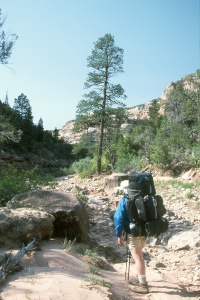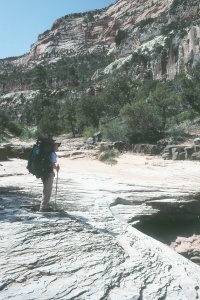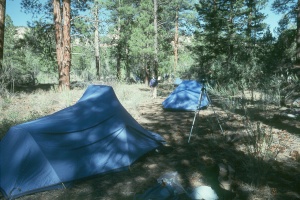Dark Canyon 2000
You Can't Go Home Anymore
Easy day up Woodenshoe
Friday, May 12 We awoke to a frosty 32 degrees. That is 31 degrees cooler than it had been the previous morning. It felt great. It is true we were about a thousand feet higher in elevation, but that could only account for about a tenth of the difference. Nobody seemed to be in a big hurry, probably due to yesterday's high intensity fun. I think there was a bit of savoring of the low temperatures going on as well. We were not out of camp until 9:20 am, about an hour later than ususal. George as usual, was out of camp first. We were right behind, but Sue, Andy, and Lance quickly passed us. Frankly, I do not remember as much about this day as others. (Click here for a 3D rendering of this and the next day's route.) I think that is mostly due to the strong path that leads across the sand/grass benches. 17 years ago, it was not so strong, and because for so much of the route this time, there was no water in the stream bed, there was a tendancy not to be drawn to the stream bed as much. On the first trip, I had found this huge pool in a large open area, right under a 10 foot pour off. I kept looking for it today, but never found it. I probably passed it while hiking up on a bench somewhere.
 This part of the canyon/trip feels much different than the earlier part, probably because of all the huge ponderosa pine, with scattered with fir and spruce. More like hiking in the dry foothills of the Sierras than in canyon country. We rolled along at a pretty good clip, crossing the wash many times, enjoying all the blooming wildflowers. There were not fields of them, but certainly large patches. The thing that most impressed me was the lack of water. Previously, we had free running water all the way down Woodenshoe, from the upper reaches, all the way to within a few hundred meters of the confluence with Dark Canyon. This time, the running water stopped a few hundred meters above last night's camp, and except for a few scattered pools, there was not much for a mile or two. We came across a couple of women out day hiking from their base camp halfway down Woodenshoe. They indicated that there was water near their camp, but that it was not continuous. We passed the spot where I thought they were camping and there was a trickle of water in the stream bed, but then it ran dry again. I was beginning to get concerned about our potential campsite for the next two days, and a potential lack of water. We seemed to hike for miles, and every time we crossed the stream bed, it would be dry as the proverbial bone. While Susie and I were carrying plenty for hiking, the prospect of extending the hike another 2 - 3 miles to get to the mouth of Cherry canyon, where there was supposed to be water, wasn't real appealing.
This part of the canyon/trip feels much different than the earlier part, probably because of all the huge ponderosa pine, with scattered with fir and spruce. More like hiking in the dry foothills of the Sierras than in canyon country. We rolled along at a pretty good clip, crossing the wash many times, enjoying all the blooming wildflowers. There were not fields of them, but certainly large patches. The thing that most impressed me was the lack of water. Previously, we had free running water all the way down Woodenshoe, from the upper reaches, all the way to within a few hundred meters of the confluence with Dark Canyon. This time, the running water stopped a few hundred meters above last night's camp, and except for a few scattered pools, there was not much for a mile or two. We came across a couple of women out day hiking from their base camp halfway down Woodenshoe. They indicated that there was water near their camp, but that it was not continuous. We passed the spot where I thought they were camping and there was a trickle of water in the stream bed, but then it ran dry again. I was beginning to get concerned about our potential campsite for the next two days, and a potential lack of water. We seemed to hike for miles, and every time we crossed the stream bed, it would be dry as the proverbial bone. While Susie and I were carrying plenty for hiking, the prospect of extending the hike another 2 - 3 miles to get to the mouth of Cherry canyon, where there was supposed to be water, wasn't real appealing.
 I dropped my pack, and pulled out Michael Kelsey's description of the route. A lot of folks are not happy with Kelsey, either because they feel he has opened up places which would have remained "secret" for another generation, or because they get frustrated with the times he says it takes to cover certain distances. To the former critics, I say it would have happened eventually, and familiarity with the jewels of canyon country has done much to assist their protection (and, of course, increase the "wear and tear" on them). To the latter, I would say that it is important to know your own abilities. If you find that, relative to your own talents, Kelsey covers superhuman distances in record times, acknowledge that you are a mere mortal, as most of us have done, and figure your hiking times will be a factor of 2 or 3 greater. One of the truly amazing things about Kelsey's books is the amount of information that he packs into one of his maps. The longer you stare at his maps, the more they reveal. In this instance, I pulled it out, and immediately breathed a sigh of relief: the map showed "intermittent water" running in the stream bed, starting a half mile or so below where we planned to camp, above the mouth of Keyhole Arch Canyon, most of the way to Cherry Canyon. If Kelsey says it will be there, it will be there. Maybe not much, but enough to slack your thirst.
I dropped my pack, and pulled out Michael Kelsey's description of the route. A lot of folks are not happy with Kelsey, either because they feel he has opened up places which would have remained "secret" for another generation, or because they get frustrated with the times he says it takes to cover certain distances. To the former critics, I say it would have happened eventually, and familiarity with the jewels of canyon country has done much to assist their protection (and, of course, increase the "wear and tear" on them). To the latter, I would say that it is important to know your own abilities. If you find that, relative to your own talents, Kelsey covers superhuman distances in record times, acknowledge that you are a mere mortal, as most of us have done, and figure your hiking times will be a factor of 2 or 3 greater. One of the truly amazing things about Kelsey's books is the amount of information that he packs into one of his maps. The longer you stare at his maps, the more they reveal. In this instance, I pulled it out, and immediately breathed a sigh of relief: the map showed "intermittent water" running in the stream bed, starting a half mile or so below where we planned to camp, above the mouth of Keyhole Arch Canyon, most of the way to Cherry Canyon. If Kelsey says it will be there, it will be there. Maybe not much, but enough to slack your thirst.
I could tell by the "feel" of the terrain that we were getting close to camp. And sure enough, I looked up ahead in the stream bed, and there was a dark stain, indicating some water. By the next crossing, there was running water. Susie, Lance, and I rolled into camp at 2:59 pm, so it had taken about 5 hr 40 minutes to cover the 8 miles or so, including rest stops, pee breaks, lunch, and general goofing off. A&S, and George had gotten in a half hour ahead of us. The air temperature was 53 degrees, making it a near perfect day for hiking. Comfortable in the sun, and a bit too cool in the shade. The campsite is really one of the nicer ones on the trip. It is a long bench, dotted with big, no, huge, ponderosa pines, and the ground is covered with pine needle mulch, the kind you would pay big bucks for back in the city, and littered with pine cones. There is a small fire ring, lots of broken afternoon shade, and nice rock shelf on which to cook dinner across from camp, and even a tad of running water in the creek. Susie and George and I headed back downstream to get cleaned up, while the others made their way into camp. Several times on these group trips, other hikers have commented that our crew looks like an ad for Sierra Designs tents, and I guess that is true. Between the 2- and 3-person Clip Flashlights, Sierra Designs made 6 of the 8 tents on the trip. Interestingly, they were all lined up in a long row in camp, due more to the linear nature of the campsite, than any desire, subconscious or otherwise, to be organized.
 At the risk of sounding like I am obsessing on water, here is another water observation: while we were cooking dinner that evening, we noted that the water level was dropping dramatically in the creek bed. Like several inches in the course of two hours or so. Most of us filled up our water bags, just in case this meant the end of the water. The next morning, we noted that the water was back up again. We are not sure, but think this may be a combination of vegetation transpiration effect (the trees suck up water during the day as they are making "food") and maybe a high country snow melt cycle. Again, we are not sure, but the effect, especially when there is not much water to start with, grabs your attention. We all turned in a bit earlier than usual, the second full day of hiking having taken its toll, and frankly, the nice, fluffy goose down sleeping bag was going to feel good, especially with the temperature falling.
At the risk of sounding like I am obsessing on water, here is another water observation: while we were cooking dinner that evening, we noted that the water level was dropping dramatically in the creek bed. Like several inches in the course of two hours or so. Most of us filled up our water bags, just in case this meant the end of the water. The next morning, we noted that the water was back up again. We are not sure, but think this may be a combination of vegetation transpiration effect (the trees suck up water during the day as they are making "food") and maybe a high country snow melt cycle. Again, we are not sure, but the effect, especially when there is not much water to start with, grabs your attention. We all turned in a bit earlier than usual, the second full day of hiking having taken its toll, and frankly, the nice, fluffy goose down sleeping bag was going to feel good, especially with the temperature falling.
© Roger A. Jenkins, Suzanne A. Mcdonald, 2000
